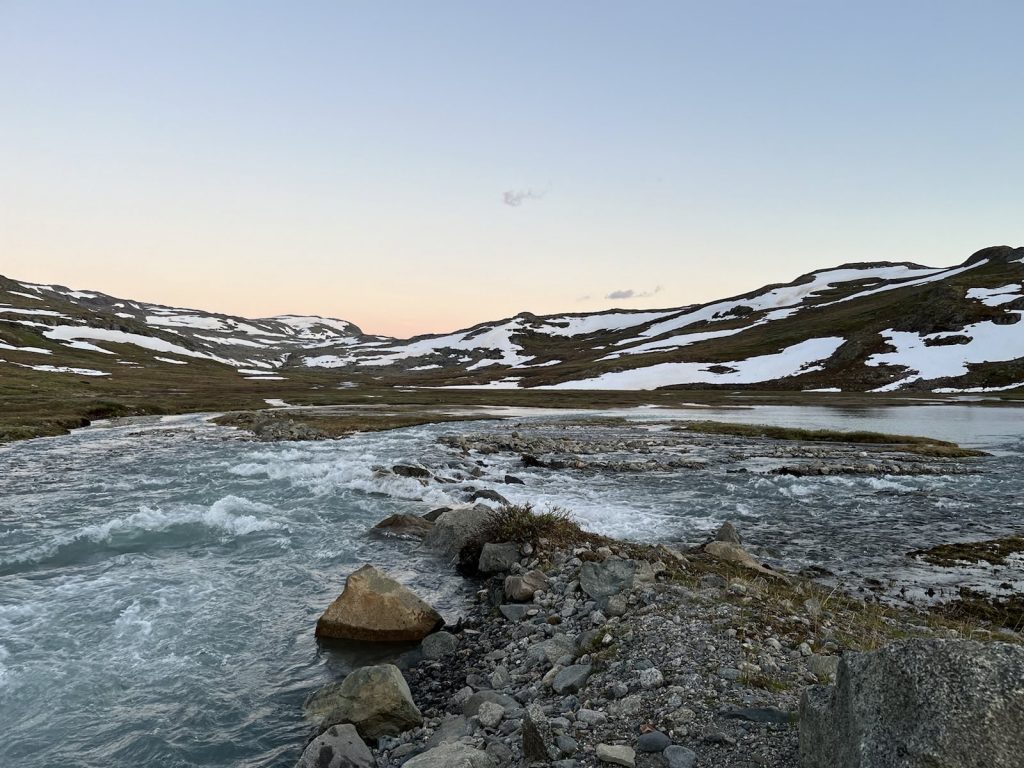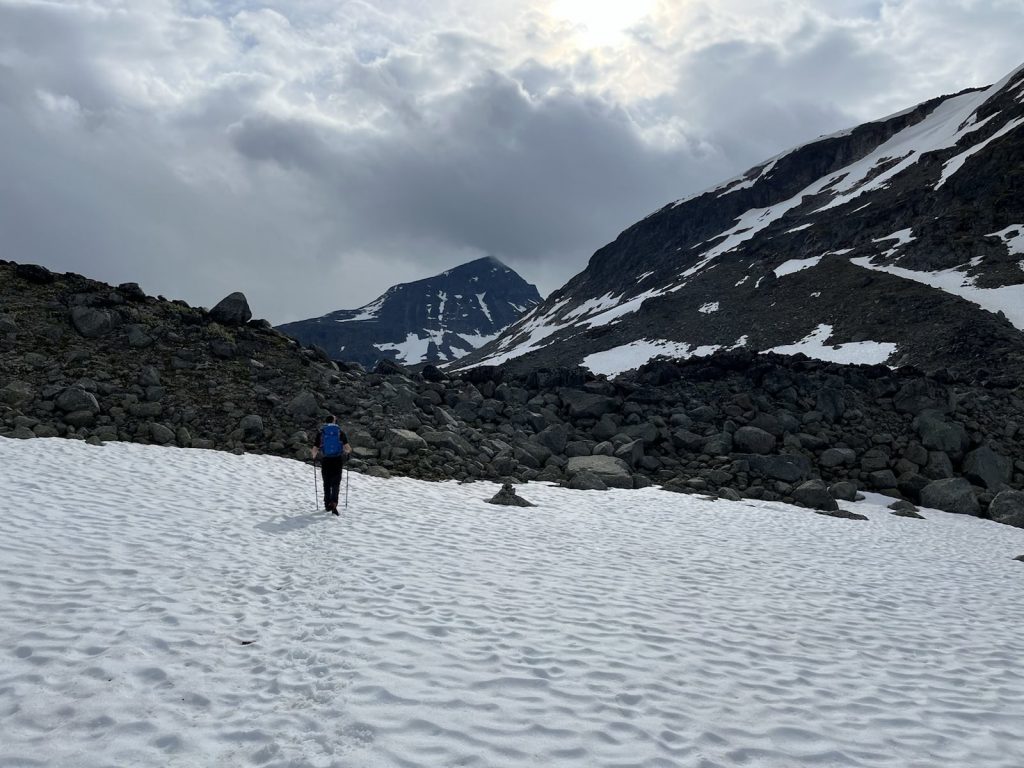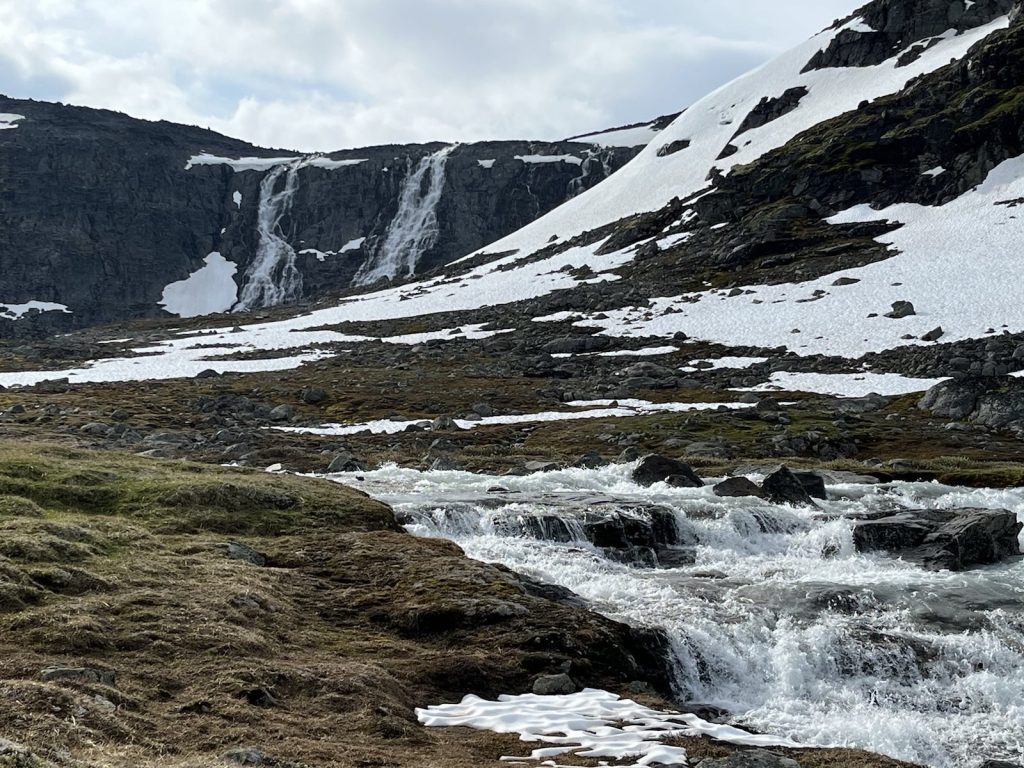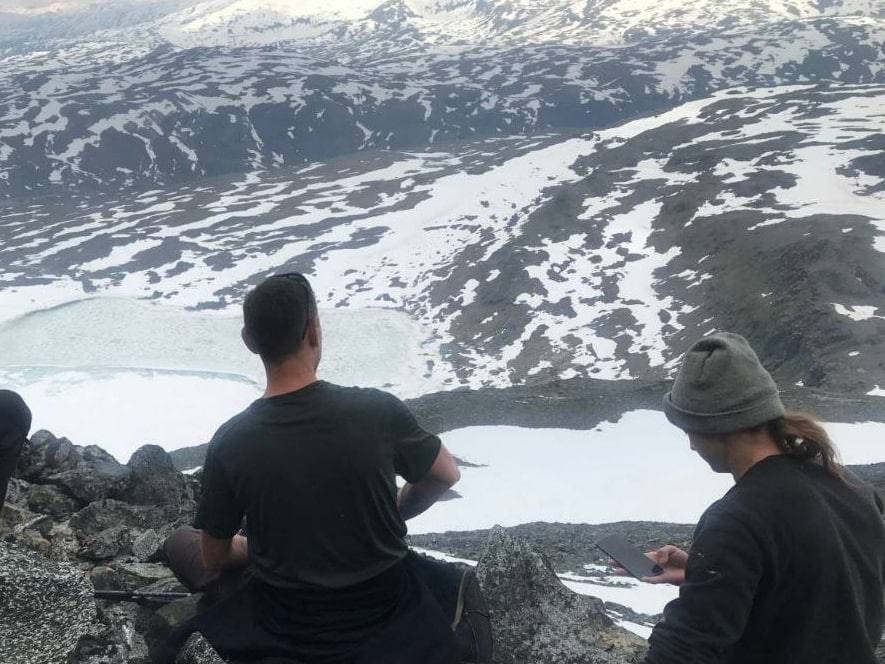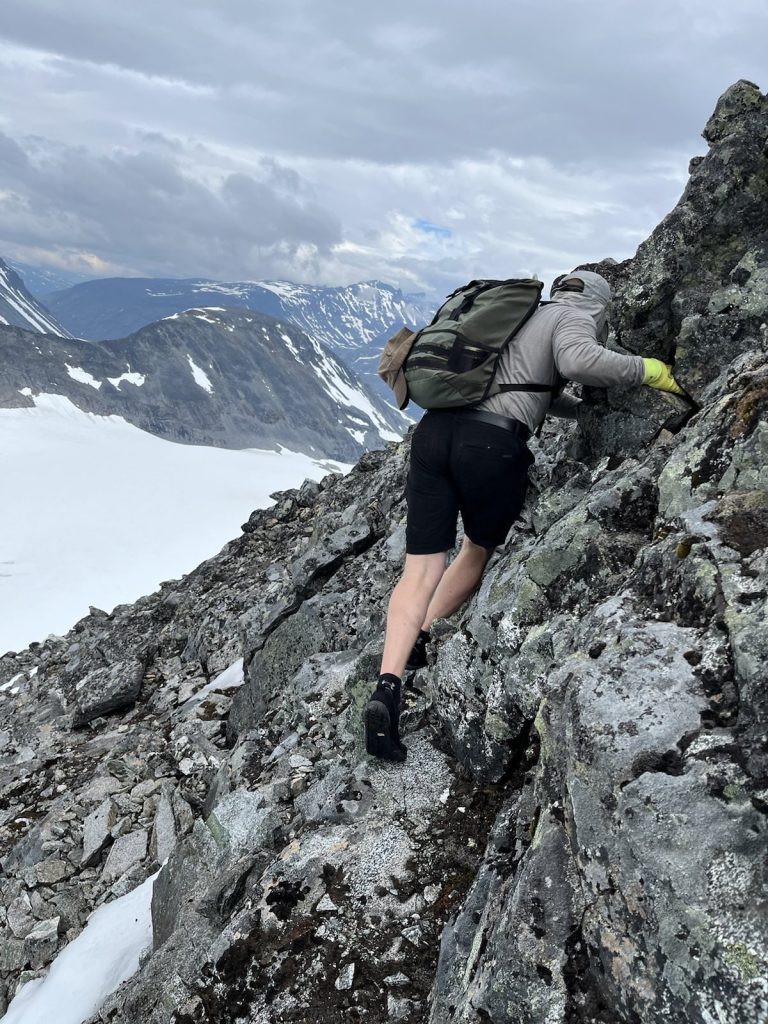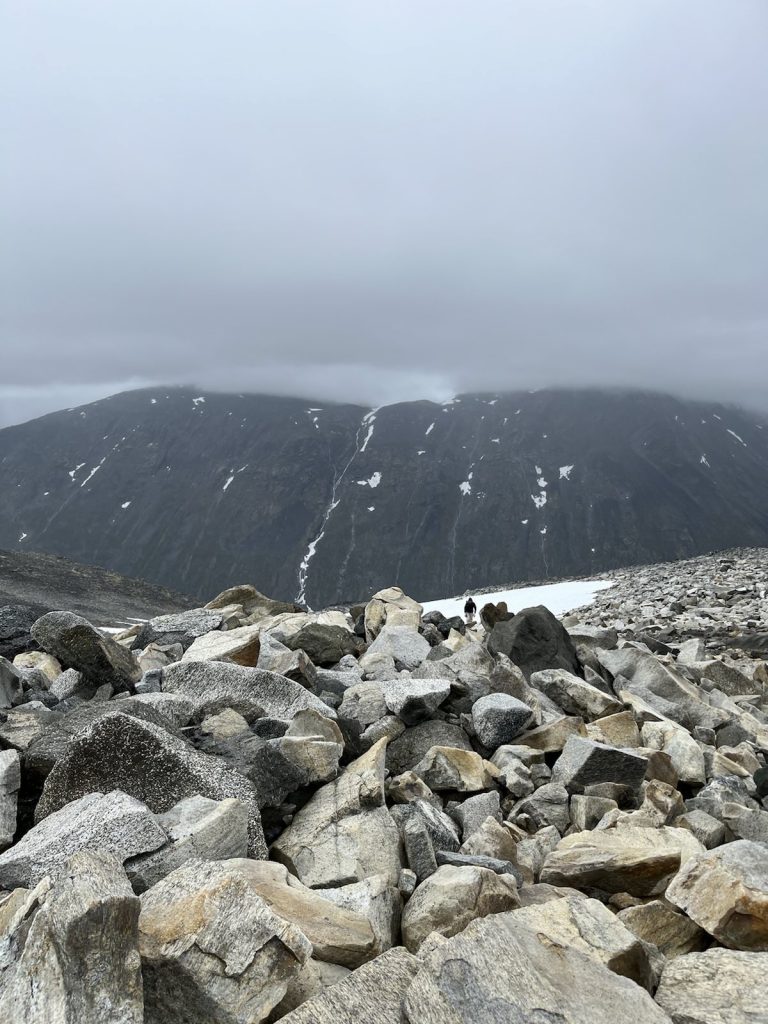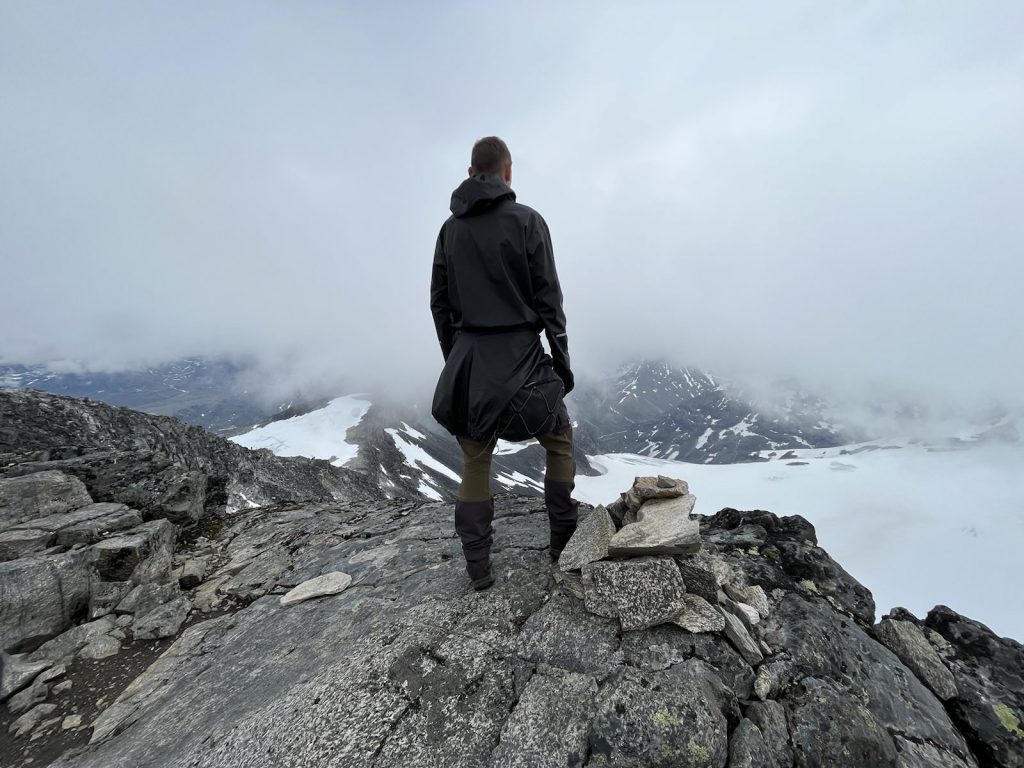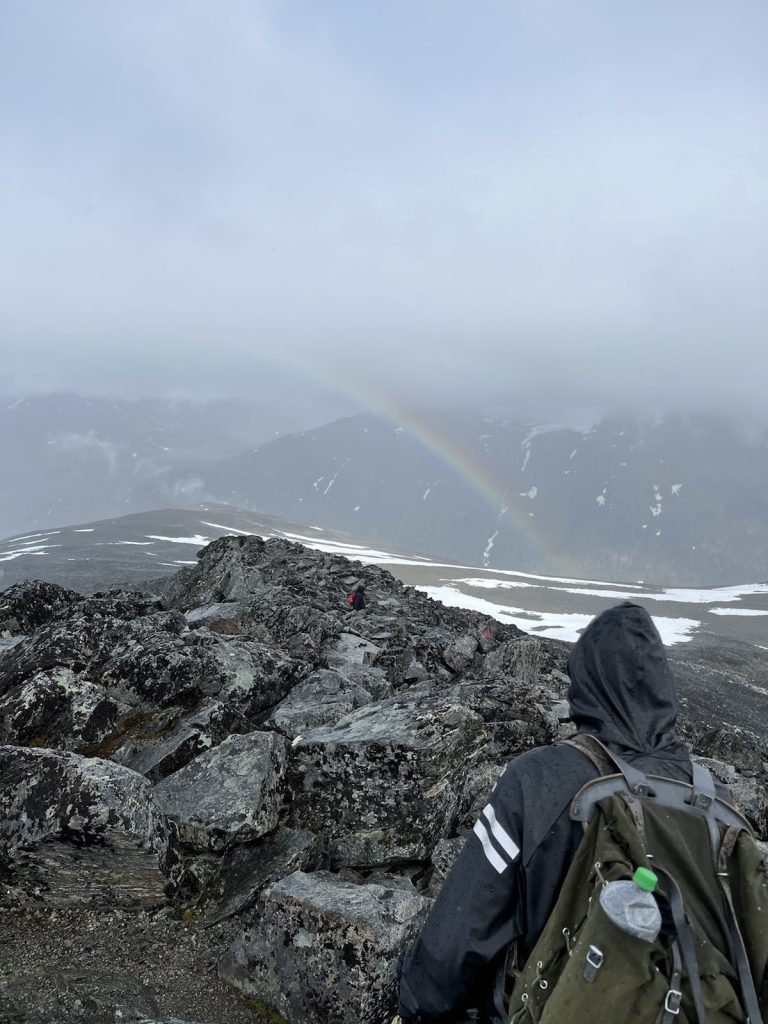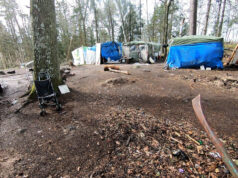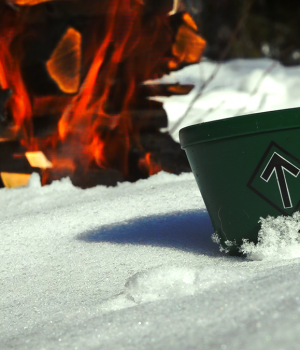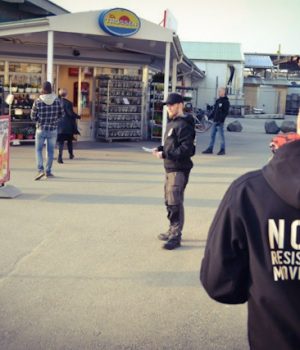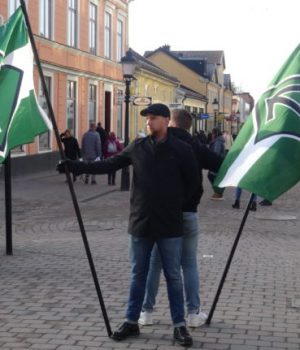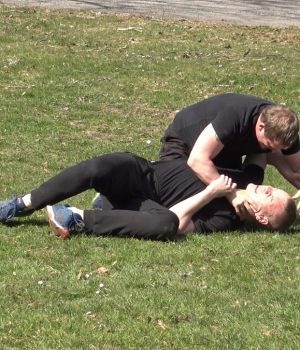RESISTANCE MOVEMENT. An extensive personal report from one of the participants of a recent trip to the summit of Galdhøpiggen.
The Nordic Resistance Movement once more organised an excursion to the national park of Jotunheimen in Norway, famous for its magnificent mountainous landscape, its ancient glaciers, its awesome mountain ridges and peaks and its unpredictable weather conditions all year round. The group, which comprised members and friends, set the goal of conquering two peaks above 2,200m within two days, a goal which proved to be more challenging and strenuous than expected, especially for those with no previous experience in similar expeditions.
We arrived at Jotunheimen late on Thursday night, after a long drive under a strong summer sun. As we entered this Nordic alpine enclave and started gaining altitude, the temperature dropped, and the air became chillier and purer. At a height of about 1,200m, in central Jotunheimen, our car trip was over and we made camp near a lake, which appeared to function as a reservoir for the cold, crystal-clear water rushing down the mountains in a loud and mighty river. This river then poured into a deep gorge with unchecked might and down onto the plains below, where it has been providing life to the tireless Norwegian farmers since their ancestors decided to plough these inhospitable lands long ago.
We slept satisfied, as we knew the weather conditions for tomorrow would be favourable, without scorching sun or heavy rain. We only hoped the tops would be free from clouds when we approached them.
Early the next day, the group was ready to move. We could already see our destination for the day: the staggering top of Store Smørstabbtinden, at 2,208m, free from clouds! Our camping place was on a small plane far below the plateaus west of the mountain, and from our position only the summit was visible. We studied the map and agreed upon a route that would bypass the extra steep and dangerous parts but would add a few extra kilometres to our hike.
We followed the mighty river up to the first plateau, where we could examine the landscape better – and what a landscape it was! On our right side we could see tall, vertical cliffs that supported the eastern borders of the Smørstabbrean glacier and generated many spectacular waterfalls supplying the river we had been following from the beginning. In front of us, the Smørstabbtinden massif stood proud, ageless, intimidating and indifferent to our small party, who looked like dwarves surrounded by giants!
Beautiful, steep and unapproachable summits (to unequipped amateur mountaineers like us) connect to the highest peak – our destination – via knife-edge mountain ridges towards the south, while to the north our mountain curves gently down to smoother, snow-covered peaks, which we would have to walk beneath in order to reach the last flat area before the final climb to the top. We made our way along the same river until we finally came to its source, the mountain lake on the base of Leirbrean glacier.
This glacier is truly extraordinary. Sloping down a semi-circular mountain ridge, climbing to almost 2,000m and right under our peak, the glacier radiates a mesmerising blueish colour. Cold, distant, inhospitable and magical, it stretches like an ocean of ice all around Smørstabbtinden, allowing only a relatively small and steep rocky corridor to the top. The glacier lake was completely frozen and the whole landscape was scattered with large islands of late summer snow, which we had to cross many times and which grew broader and longer as we went higher.
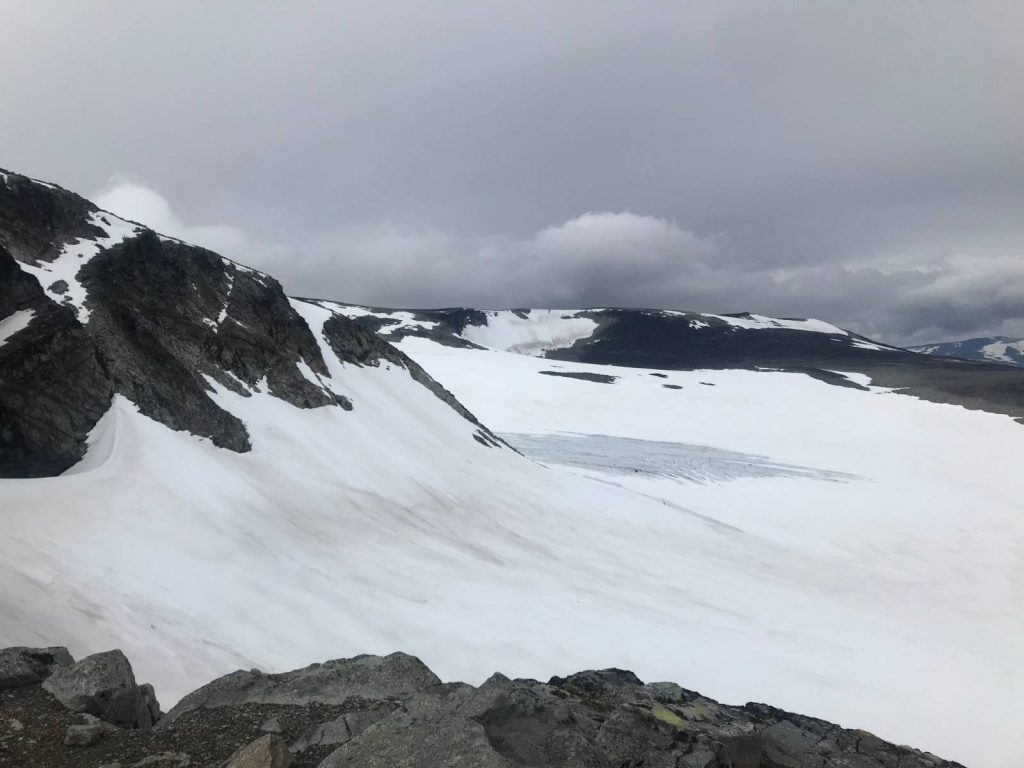
Our orientation skills were put to the test, as we had to alter our route a number of times to avoid treacherous crossings over creeks swollen by abundant rain and glacial water and snow – covered patches undermined by waters flowing below – which we could hear but not see, and which could easily collapse under our weight. As we gained altitude, the vastness, roughness and solitude of the landscape became clear to us.
The road was long gone from our sight. There were no paths, but there were sporadic patches of stones clumsily built by hikers, which could provide a rough orientation. These were of no use to us, however, because the usual routes were still blocked by water and snow and new ones had to be made. There were no houses, no people, no signs of civilization as far as the eye could see. The terrain was littered with black and grey rocks of all possible sizes and forms, broken by white patches of snow, which gave us a relieving comfort when crossing them, as they were much more comfortable to walk on.
Countless creeks, large and small, were transferring water from the snowy peaks and the glaciers through this Martian landscape, down to the planes, unforeseeable and ever-flowing.
An eerie, mystical silence dominated the landscape, amplified by the marvellous sight of gigantic vertical peaks rising around us. Despite all their might and dramatical severity, the mountains inspired us with a sense of comforting tranquillity and calm alertness, which is impossible to describe adequately in words or capture in pictures. A true pilgrimage to the last abode of the Gods of the North.
Within a few hours, we reached the final stop before the peak: a flat part of the mountain ridge between our peak and the neighbouring mountain. We paused to catch our breath, rest our legs, focus our minds and plan for the final ascension. The top of Smørstabbtinden was now rising like a mythological monument 200 metres above us. This staggering pyramidal formation can only be climbed via its north side. To the west and east, there are almost vertical cliffs rising many hundreds of metres high from the glaciers below, while the south side, almost as steep, leads to the next peak (Sokse 2,189m) via a razor-sharp ridge appropriately named “Kniven” (The Knife).
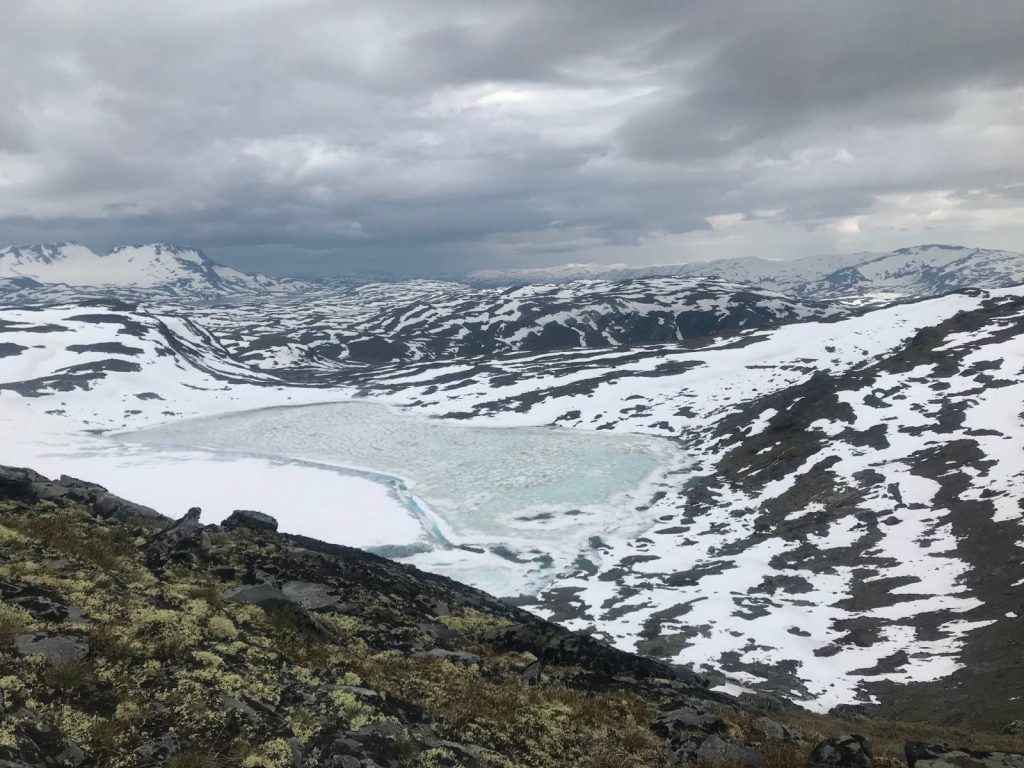
The only way up to the top would offer us what was for me the most exciting part of our hike – climbing! A steep wall, about 150m high, was towering in front of us and would require good climbing skills, balance and composure – and of course the use of both hands. It is the kind of climb that is on the limits of technical climbing: a little bit steeper and it would be impossible to do without ropes, harnesses and other mountaineering equipment. A real challenge that would test us both physically and mentally. We pushed on with focus and perseverance and made it up safe and content.
A few hundred metres of milder ascent was now separating us from the top; it all came down to the weather. Getting to the summit in a cloud of mist is too dangerous for such sharp, narrow and treacherous peaks. Orientation is almost impossible, unless you know the area like the palm of your hand, stone for stone; otherwise the risk of losing your way and descending the wrong side could be the last thing you do. We were worried. During our climb we could see dark clouds covering the summit. A bitter disappointment was taking over. Had we come all the way here only to miss the top?
No! The first one of our group bore the right symbols on his arms, which seem to function as a ritual key in these mountains. The Gods guarding the peaks recognised them and let us through. The dark clouds dispersed, and the glorious sun illuminated the peak! We were there!
A friendly breeze cooled our overheated bodies, and the views were staggering. Impossible to catch in pictures and meaningless to describe in words. One has to be there to understand.
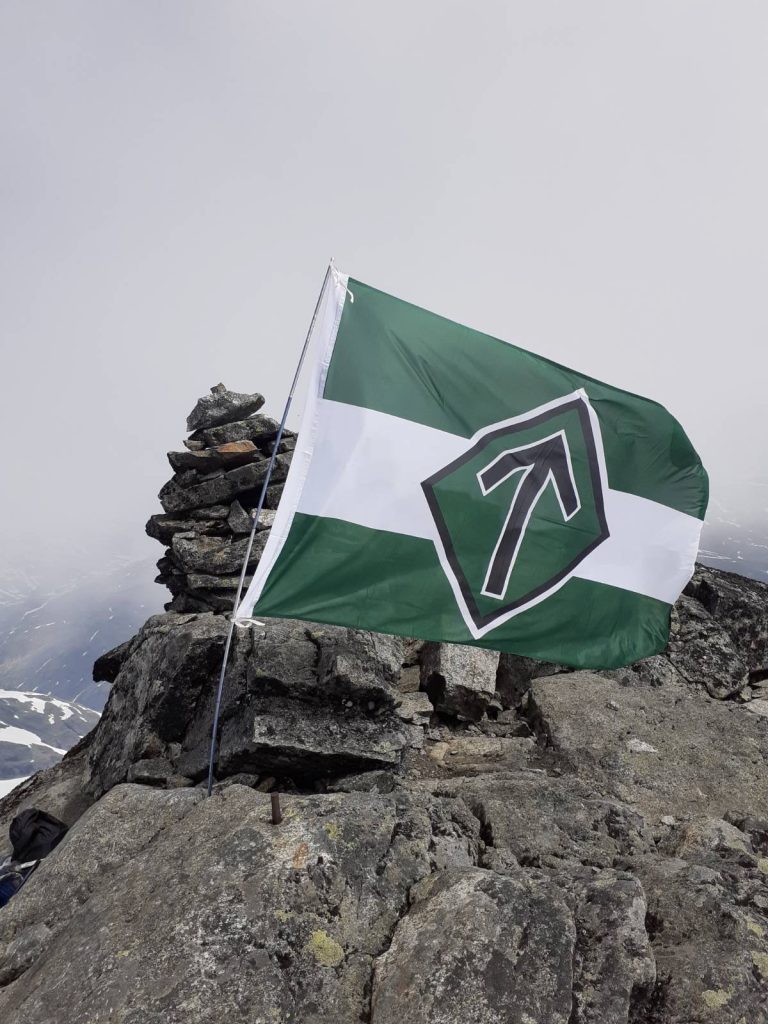
The descent of the vertical wall was more dangerous than the ascent. The group kept its composure and made it down without problems or accidents. No boots or hands lost their grip and no stones fell on our heads. As we were hiking away from the pyramid, the weather changed and rain started to fall. The Gods gave us the window we needed, but that was it.
For the rest of the hike, we would “enjoy” bitter mountain weather. Rain, mist and greyness. We replanned our route down, as we could see a crossing over a river that we had avoided during our ascent. It was steeper but possible, and saved us a couple of arduous kilometres. The rest of the road was long but safe and predictable. We were content with our success, and nothing else mattered. We studied the landscape once more and tried to take it in and etch it into our memories, both the views and the feelings that arose – unforgettable!
A few hours later we were at our camp. Resting, eating and preparing for the next adventure the day after, when we would climb Galdhøpiggen – which, at 2,469m, is the highest peak in the North.

The next morning we had a quick breakfast and drove to our destination, the mountain lodge under Galdhøpiggen. This hike would be less challenging and adventurous but more physically demanding because the ascent was about 1,400m, compared to approximately 1,000m the day before.
The highest mountain in Scandinavia attracts many visitors, and the conventional routes to the top can be busy. Meeting colourful crowds of people is not what we were looking for on our mountain adventure, as it can almost poison the experience. On the other hand, we do appreciate outdoors people who seek out the mountains and would rather sweat and toil on the steep slopes of Jotunheimen for reasons we share, instead of “relaxing” and “resting” from the routines of their lives down on the planes.
Moreover, climbing the highest mountain in the North contains an ideological and spiritual symbolism which awakens an unexplainable attraction to conquer that sacred peak, similar to our efforts to conquer ourselves and our individual and common goals.
With these thoughts in our heads and mixed feelings, we began our hike. The way to the top is an almost unending uphill trek that will challenge even the best trained mountaineer. The first 700m of ascent were hard, as you zig-zag on very uneven, steep paths that lead away from the narrow valley below, with its moderate climate and landscape, up to the first snowy slopes and the glaciers of the mountain massif, crowned by the peak of Galdhøpiggen.
As soon as we entered the more alpine environment, the weather turned. Clouds and mist blocked our view, and for the rest of the day, we would only enjoy short glimpses of the spectacular tops, mountain ridges, cliffs and glaciers that dominate the heart of the national park. However, the limited view has its advantages. When clouds and mist block the horizon and all you see beyond a few hundred metres is whiteness, your focus turns inwards. You can better feel the rhythm of your body struggling uphill; you can concentrate on your breathing and observe and control your physiology more efficiently.
Similarly, the mind – lacking powerful external stimuli – turns inwards into a state of alert meditation, which is excellent for contemplating and philosophising questions both great and small that perplex one’s thoughts. As we pushed on, the harshness of the terrain revealed itself once more, just like the day before. An almost alien landscape where nothing grows, littered with rocks and stones of all possible sizes and formed by the weight of the ancient glaciers that persevered in Jotunheimen long after they retreated from the rest of Scandinavia. A landscape constantly changing on account of powerful waterfalls and enormous amounts of snow falling every long winter.
Snow-covered slopes, which we had to cross many times, reminded us that summer never really comes to Jotunheimen, and that the conditions here are controlled by a strict micro-climate specific to the area and independent of the weather and the seasons below. We had sun, rain and snow, all within a period of a few hours – and as the weather changed rapidly, we were struggling to keep our mood stable.
The route to Galdhøpiggen is spectacular. We passed two peaks over 2,000m, which stood like landmarks on the way up, crossed ridges where one side was an almost vertical cliff hundreds of metres tall, and made some use of our hands at the most difficult passages. The path was well marked, and orientation was never a problem, even when we couldn’t see more than 30 metres ahead of ourselves. We could feel we were approaching the peak, but every time we would come to the end of our visibility in the cloudy mist ahead, a new slope would appear. Then, as excitement, anticipation and frustration increased, we finally saw the small “monument” marking the peak.
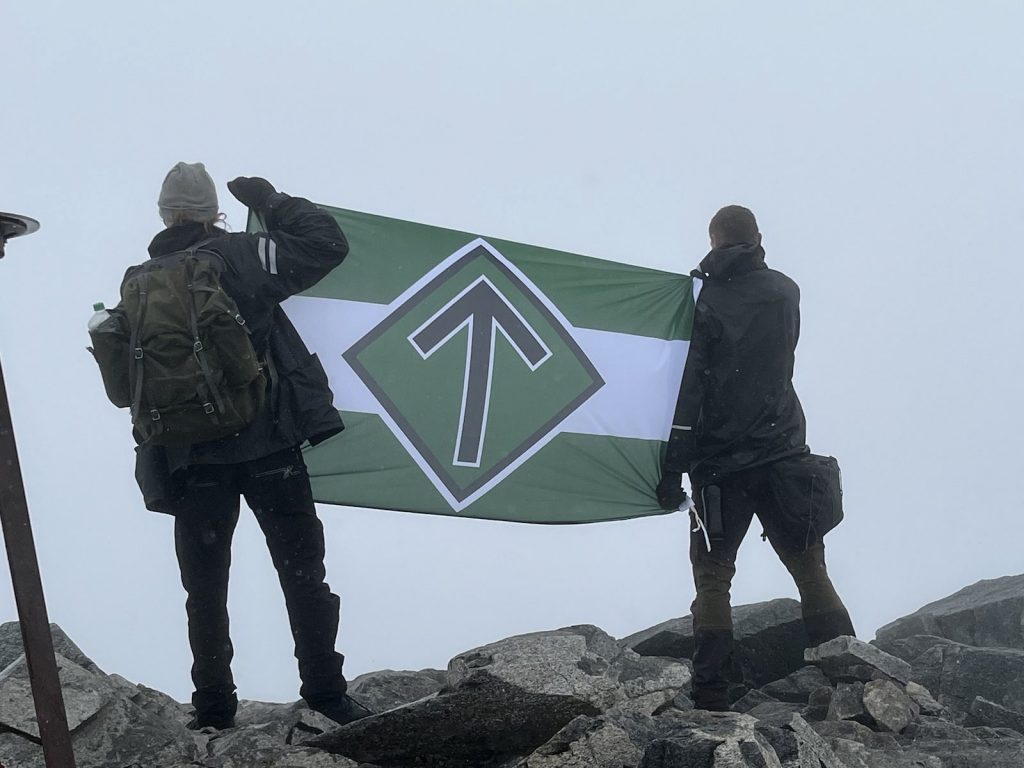
The group gathered round, shook hands and congratulated one another on the successful and safe ascent. The mood was cheerful, as all of us were satisfied with our little achievement. The route down was uneventful, under similar weather conditions and easier, because now we could almost run down, gliding on the snowy slopes with ease and comfort, with gigantic smiles on our faces.
As I mentioned earlier, Galdhøpiggen attracts many visitors during the summer season, and we came across some very interesting groups of people.
We saw families with young children, five to ten years old, making it all the way to the peak. Step by step, steady and slowly, in rain and snow, those amazing youngsters pushed themselves up, climbing with hands and feet over stones we just walked over. We greeted and congratulated both parents and children for their astonishing efforts, satisfied there are still families who raise young Vikings, despite the degeneracy and temptations of the average life below.
We met a group of teenagers escorting their brave friend, who walked all the way to the top in roller-skates, just for the fun of it, as a personal challenge. Some may think this rather stupid, but I cannot help but admire this polite young man’s stamina, stubbornness, perseverance and patience – virtues that are extremely rare nowadays, especially in the youth. We know he made it to the top, and if he is reading this, we congratulate him once more and urge him to join us!
We saw athletes competing in a mountain ultramarathon. The race began at the mountain lodge of Glitterheim at 1,384, up to the top of Glittertinden at 2,452m, down to the valley at 1,111m, up to the top of Galdhøpiggen at 2,469m, down to the valley again at 1,111m and up to a plateau at 1,841m! Please read this again so you understand what a formidable accomplishment this was! These amazing men and women run and strove up and down the mountains with unsurpassable strength and stamina that seemed almost superhuman. A true elite of athletes exercising a sport for nobles.
The mountain area of Jotunheimen is a spectacular monument of authentic Nordic nature. The physical and mental impression it made on me is similar to the pictures my fantasy created inside my head when I read the unique Nordic myths for the first time. The Nordic Gods and Heroes can only have been born in this landscape, and the landscape itself reflects all their qualities and powers. It is pure, hostile, dramatic and awe-inspiring. Cold, unforgiving, intimidating and magnificent.
Being there, your mindset readjusts, and a primitive, ancient and almost sacred consciousness arises. A consciousness suppressed by the never-ending thoughts that often overwhelm our minds, but are now reawakened by the magical strength of these isolated mountains. Nowhere else in Scandinavia is the Nordic soul more accurately imprinted on the landscape, and no other landscape can better attribute the rich, profound and complex totality of the term Nordic. We felt at home.
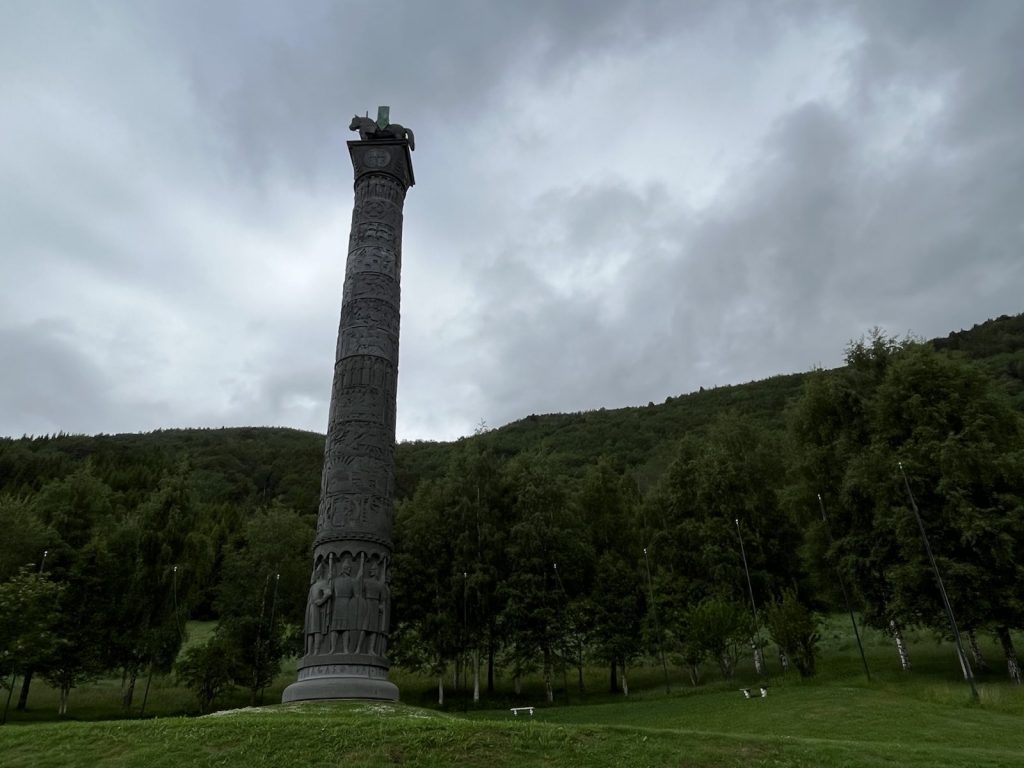
The Saga Column
This amazing monumental pillar stands 34m tall (one of the tallest in the world), outside the Elveseter Hotel, in the very heart of Jotuneheimen National Park. It was created by the famous Norwegian sculptor Wilhelm Rasmussen, who won the commission issued by the Norwegian government in 1926, competing against men such as Gustav Vigeland. It was intended to become the new national monument of Norway and placed outside the Norwegian parliament. Rasmussen was the professor of sculpture at the Norwegian National Academy of Craft and Art Industry from 1921 until 1945, and was one of the last great masters of European Classical Romanticism.
He was also an active National Socialist and a member of Nasjonal Samling, and served a jail sentence for treason after the end of the Second World War. By that time, the monument was incomplete and thrown into storage in Oslo, cast into oblivion due to its creator’s political and philosophical views. The owners of Elveseter Hotel were ardent art collectors, and after accidentally rediscovering parts of the pillar in Oslo, they restored it and placed it in its current position in 1992.
The column depicts central elements in Norwegian history. The top is crowned by King Harald Harfagre, the very symbol of the transition from a divided country to unified nation. We believe modern Oslo and the country’s parliament does not deserve the pillar, and not the other way around. The current position of this astonishing piece of national art, surrounded by the glorious Norwegian mountains, is ideal and appropriate for the purpose it was built for and the symbolism it carries. It will take its rightful place in central Oslo again when the country rediscovers and reconquers the ideals and spirit the monument represents.
– Karl Folkesson


